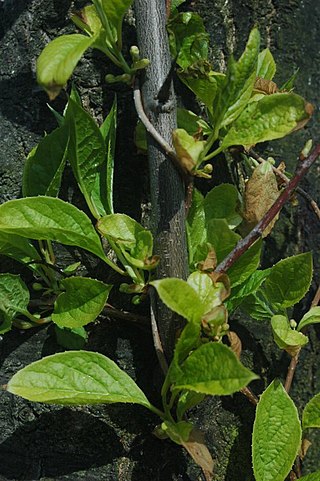
Schisandra, the magnolia vines, is a genus of twining shrubs that generally climb on other vegetation. Various authors have included the plants in the Illiciaceae
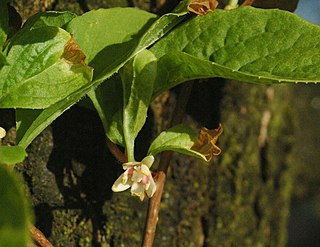
Schisandraceae is a family of flowering plants with 3 known genera and a total of 92 known species. Such a family has been recognized by most taxonomists, at least for the past several decades. Before that, the plants concerned were assigned to family Magnoliaceae and Illiciaceae.
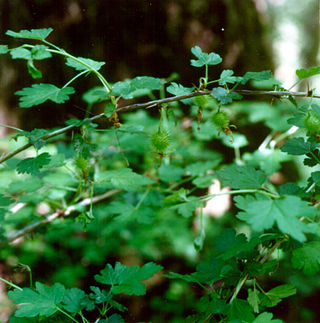
Ribes echinellum, the Miccosukee gooseberry, is a very rare North American shrub in the currant family, native to the southeastern United States. It has only a few known populations. The Florida populations were discovered first, in 1924 at Lake Miccosukee. The South Carolina populations were found in 1957 and 1981, and the first is protected at Steven's Creek Heritage Preserve.

Symphyotrichum georgianum is a rare species of flowering plant in the Asteraceae, the aster family. Its common name is Georgia aster. It is native to the southeastern United States where it is known from Alabama, Florida, Georgia, North Carolina, and South Carolina. As of 2013, it may be extirpated from the state of Florida.

Yucca aloifolia is the type species for the genus Yucca. Common names include aloe yucca, dagger plant, and Spanish bayonet. It grows in sandy soils, especially on sand dunes along the coast.
Anredera vesicaria, common names Texas madeiravine or sacasile, and the related A. cordifolia are the only two species of the family Basellaceae known to occur in the wild in the contiguous United States. Both are sometimes cultivated for their showy and fragrant floral displays. Anredera cordifolia is widespread throughout the warmer regions of the world, including outside its natural range as an invasive species. Anredera vesicaria is native to Texas as well as to Mexico, Central America, West Indies, and Venezuela and it is introduced in Florida. In Texas and Florida the species grows in thickets and in disturbed areas such as roadsides and fence rows at elevations less than 500 m.

Celtis ehrenbergiana, called the desert hackberry or spiny hackberry, is a plant species that has long been called C. pallida by many authors, including in the "Flora of North America" database. It is native to Arizona, Florida, New Mexico and Texas, and to Latin America as far south as central Argentina. It grows in dry locations such as deserts, brushlands, canyons, mesas and grasslands.

Parietaria praetermissa, the clustered pellitory, is a plant species native to the coastal plains of the southeastern United States, i.e., Georgia, Florida, Louisiana, North Carolina and South Carolina. It grows in hammocks, waste places, calcareous outcrops, etc., at elevations of 10 m.

Styrax americanus, the American snowbell or mock-orange, is a plant species native to the southeastern United States and the Ohio Valley. It has been reported from Texas and Florida to Virginia and Missouri. It generally grows in swamps and on floodplains and in other wet locations.

Samolus ebracteatus, the limewater brookweed, is a plant species known to Mexico, Central America, the West Indies, and to the United States. It is found in wetlands, including seashore salt marshes, and near springs and intermittent rivers in desert areas.

Smilax auriculata is a North American plant species native to the Bahamas, the Turks & Caicos Islands, and the southeastern United States. Common names include earleaf greenbrier and wild-bamboo, despite the fact that it is not closely related to bamboo. It is reported from Florida, Georgia, North and South Carolina, Alabama, Mississippi, and Louisiana. It grows on coastal sand dunes and in sun-lit locations in sandy woodlands at elevations of less than 100 m.

Kalmia hirsuta, the hairy mountain-laurel, is a plant species native to the southeastern United States. It is reported from Florida, Georgia, Alabama and South Carolina. It grows in open, sandy locations such as savannahs, sand hills and pine barrens at elevations of less than 100 m (330 feet).
Calycocarpum (cupseed) is a monotypic genus of plants in the family Menispermaceae. The only species currently accepted is Calycocarpum lyonii endemic to the southeastern United States.

Parietaria floridana, common name Florida pellitory, is a plant species native to the southeastern United States, the West Indies, and much of Latin America. In the US, the heart of its range extends from Florida, to Georgia and North and South Carolina, with isolated populations reported in Mississippi, Louisiana, Texas, New Hampshire, Kentucky and Delaware. Some populations in California have in the past been referred to as P. floridana but are now regarded as a separate species, P. hespera.

Lyonia fruticosa, the poor-grub or coastal plain staggerbush, is a plant species native to the US states of Florida, southern Georgia and the extreme southern part of South Carolina. It grows in pine woodlands and shrub bogs at elevations less than 100 meters.
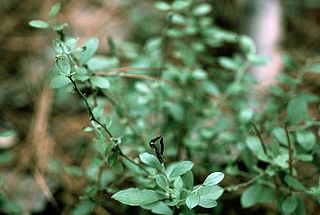
Vaccinium tenellum, the small black blueberry is a plant species native to the southeastern United States from southeastern Mississippi to northern Florida to southern Virginia. It grows in forests and in shrubby areas at elevations up to 200 m.
Spermacoce glabra, smooth false buttonweed, is a New World species of plants in the coffee family.

Liparis liliifolia, known as the brown widelip orchid, lily-leaved twayblade, large twayblade, and mauve sleekwort, is a species of orchid native to eastern Canada and the eastern United States. It can be found in a variety of habitats, such as forests, shrublands, thickets, woodlands, and mountains. The orchid is considered globally secure, but it is considered rare or endangered in many northeastern states.

Iris hexagona, commonly known as the Dixie iris, is a species in the genus Iris, it is also in the subgenus Limniris and in the series hexagonae. It is a rhizomatous perennial with long bright green leaves, long thin stem and has small groups of flowers in shades of blue, from violet, to bluish purple, to lavender. It flowers in springtime and is native to the southeastern and south-central US states.
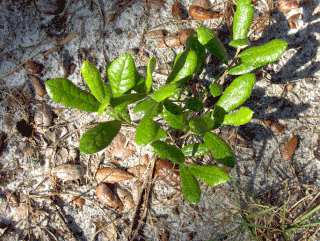
Quercus pumila, the runner oak or running oak, is a species of oak. It is native to the southeastern United States.


















